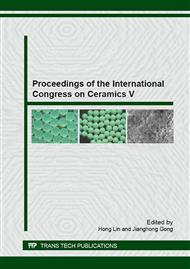p.1
p.6
p.11
p.17
p.22
p.27
p.32
p.36
Effect of Milling Parameters on Microstructure and Selected Mechanical Properties of Si3N4 – Graphene Composites
Abstract:
In the presented work the effect of graphene platelets (GPLs) grade and mixture homogenization parameters on the microstructure and selected properties of Si3N4 – graphene composites have been investigated. Three different commercial grades of the multilayer graphene platelets were used as a filler for ceramic matrix. The mixtures of silicon nitride powder with 2wt% of GPLs were prepared using planetary mill at 200 – 400 rpm for 1 – 16 h. The water, acetone and isopropanol have been tested as a wetting medium. The composites were sintered using Spark Plasma Sintering – SPS at 1650 °C under 35 MPa of uniaxial pressure during the whole cycle. Microstructure, density, Young modulus, hardness and indentation fracture toughness of the sintered samples have been investigated. The microstructure homogeneity of the composites depends mainly on the milling duration. Milling process should last for about 4 – 8 h at 200 rpm for optimum results. Mechanical properties of the composites are slightly varied depending on the mixture preparation parameters. The homogenization time has a little stronger influence on the Young's modulus and hardness in the case of composites containing larger graphene sheets, in connection with the fragmentation of its microstructure. The best properties have composites reinforced by the GPLs characterised both by the smallest thickness and lateral size of nanosheets.
Info:
Periodical:
Pages:
17-21
Citation:
Online since:
July 2015
Price:
Сopyright:
© 2015 Trans Tech Publications Ltd. All Rights Reserved
Share:
Citation:


